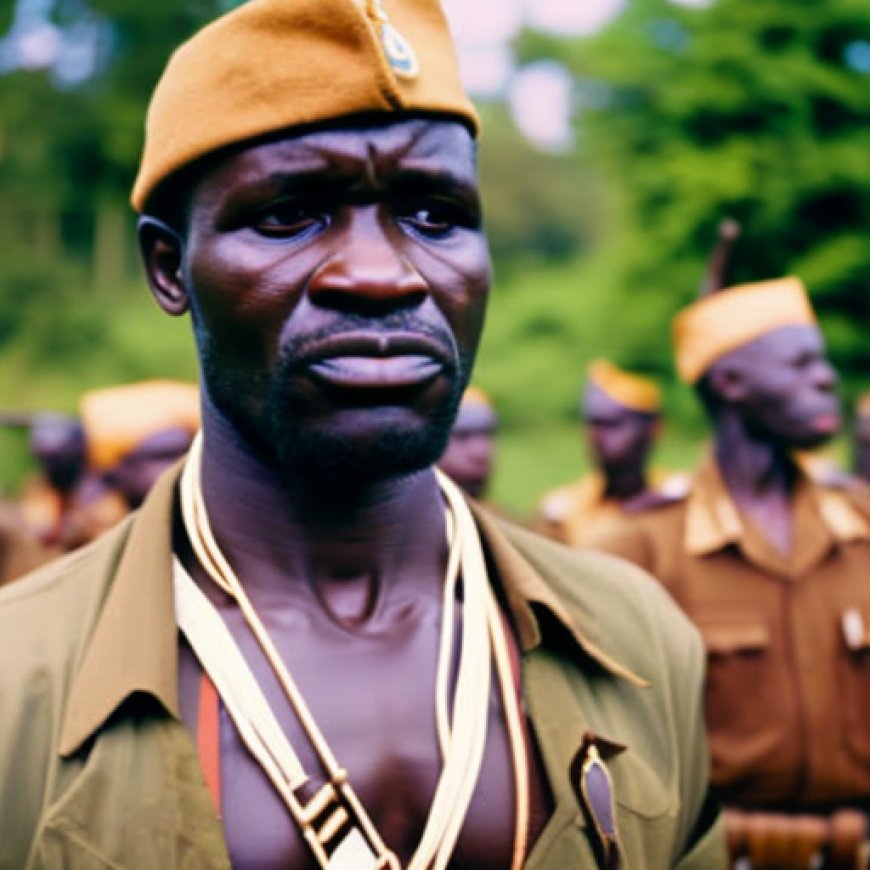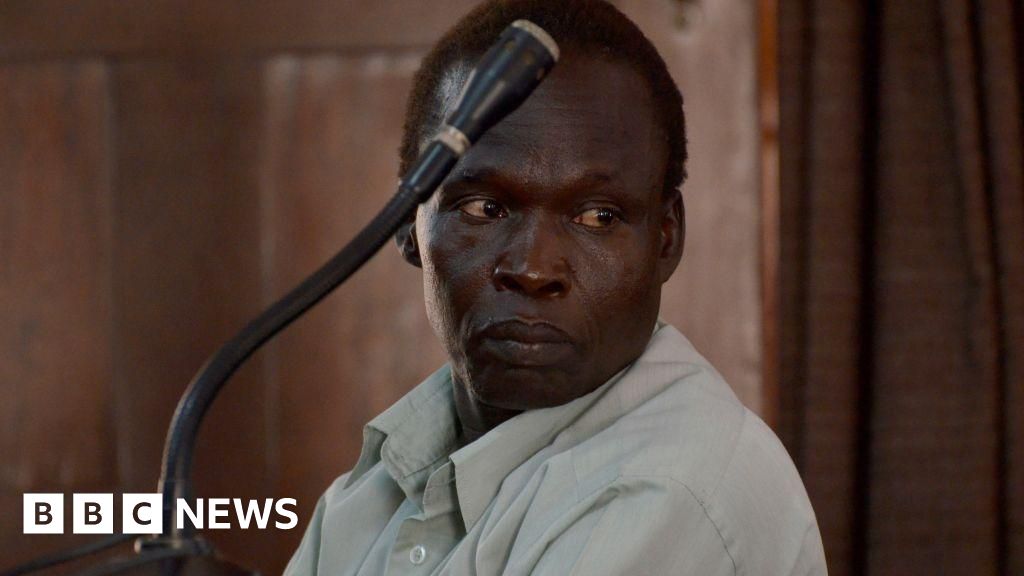Thomas Kwoyelo: Lord’s Resistance Army rebel convicted of war crimes in Uganda


Sustainable Development Goals (SDGs) and the Conviction of a Former Child Soldier in Uganda

Introduction
A child soldier-turned-rebel commander in the notorious Lord’s Resistance Army (LRA) has been convicted of war crimes and crimes against humanity in a landmark case in Uganda.
Thomas Kwoyelo was found guilty on 44 counts including murder, kidnap, and pillaging. He denied all 78 charges that were brought against him. Of the remaining 34 charges, Kwoyelo was acquitted of three murder charges and 31 other charges were dismissed.
Significance of the Conviction
Kwoyelo becomes the first LRA commander to be tried by a Ugandan court, marking a watershed moment for the country’s judicial system. The trial was held in Gulu city in northern Uganda – the region that was terrorized by the LRA for more than two decades.
In a dark suit and red tie, the former LRA commander showed no emotion in response to the long list of guilty verdicts. A judge read out the names of civilians who were killed on Kwoyelo’s orders. One notorious incident was an attack on a camp for displaced civilians at Pagak in northern Uganda in 2004. Dozens of women and children were beaten to death with wooden clubs.
The Lord’s Resistance Army and the Sustainable Development Goals
Joseph Kony formed the LRA in Uganda more than two decades ago, claiming to be fighting to install a government based on the Bible’s 10 Commandments. The group was notorious for chopping off people’s limbs and abducting children to use as soldiers and sex slaves. Hundreds of thousands of people were forced from their homes by the conflict.
This case highlights the importance of the Sustainable Development Goals (SDGs) in addressing the root causes of conflicts and promoting peace, justice, and strong institutions. SDG 16 specifically focuses on promoting peaceful and inclusive societies for sustainable development, providing access to justice for all, and building effective, accountable, and inclusive institutions at all levels.
Conclusion
The conviction of Thomas Kwoyelo is a step towards accountability for the crimes committed during the 25-year conflict in Uganda. While the LRA has largely been wiped out, its leader Joseph Kony, who is wanted by the International Criminal Court (ICC) for crimes against humanity, remains at large.
It is crucial for countries to continue their efforts in implementing the SDGs, particularly SDG 16, to ensure justice, peace, and security for all. This includes addressing the root causes of conflicts, providing support to victims, and holding perpetrators accountable.
Furthermore, it is important to acknowledge the need for comprehensive rehabilitation and reintegration programs for former child soldiers like Kwoyelo, who were victims themselves before becoming perpetrators. By addressing the underlying issues that lead to the recruitment and use of child soldiers, we can work towards preventing future conflicts and promoting a more peaceful and just world.
SDGs, Targets, and Indicators Analysis
1. Which SDGs are addressed or connected to the issues highlighted in the article?
- SDG 16: Peace, Justice, and Strong Institutions
- SDG 5: Gender Equality
- SDG 4: Quality Education
The article discusses the conviction of a former child soldier-turned-rebel commander for war crimes and crimes against humanity. This highlights the importance of achieving peace, justice, and strong institutions (SDG 16) to address and prevent such atrocities. The mention of the LRA’s practice of abducting children as soldiers and sex slaves also connects to the goal of promoting gender equality (SDG 5) and protecting the rights of children. Additionally, the article mentions the impact of the conflict on displaced civilians, indicating the need for quality education (SDG 4) to ensure access to education for all, even in conflict-affected areas.
2. What specific targets under those SDGs can be identified based on the article’s content?
- Target 16.1: Significantly reduce all forms of violence and related death rates everywhere
- Target 5.2: Eliminate all forms of violence against all women and girls in the public and private spheres
- Target 4.1: Ensure that all girls and boys complete free, equitable, and quality primary and secondary education
The article highlights the conviction of the former rebel commander for war crimes, indicating progress towards Target 16.1 of reducing violence and related death rates. The mention of the LRA’s practice of abducting children as soldiers and sex slaves connects to Target 5.2 of eliminating violence against women and girls. Lastly, the article emphasizes the impact of the conflict on education, highlighting the need to ensure that all children, including those affected by conflict, have access to quality education, aligning with Target 4.1.
3. Are there any indicators mentioned or implied in the article that can be used to measure progress towards the identified targets?
- Indicator 16.1.1: Number of victims of intentional homicide per 100,000 population, by sex and age
- Indicator 5.2.1: Proportion of ever-partnered women and girls subjected to physical, sexual, or psychological violence by a current or former intimate partner in the previous 12 months, by form of violence and by age group
- Indicator 4.1.1: Proportion of children and young people (a) in grades 2/3; (b) at the end of primary; and (c) at the end of lower secondary achieving at least a minimum proficiency level in (i) reading and (ii) mathematics, by sex
The article does not explicitly mention specific indicators. However, progress towards Target 16.1 can be measured using Indicator 16.1.1, which tracks the number of victims of intentional homicide. Indicator 5.2.1 can be used to measure progress towards Target 5.2 by monitoring the proportion of women and girls subjected to violence. Indicator 4.1.1 can be used to measure progress towards Target 4.1 by assessing the proficiency levels of children and young people in reading and mathematics.
4. Table: SDGs, Targets, and Indicators
| SDGs | Targets | Indicators |
|---|---|---|
| SDG 16: Peace, Justice, and Strong Institutions | Target 16.1: Significantly reduce all forms of violence and related death rates everywhere | Indicator 16.1.1: Number of victims of intentional homicide per 100,000 population, by sex and age |
| SDG 5: Gender Equality | Target 5.2: Eliminate all forms of violence against all women and girls in the public and private spheres | Indicator 5.2.1: Proportion of ever-partnered women and girls subjected to physical, sexual, or psychological violence by a current or former intimate partner in the previous 12 months, by form of violence and by age group |
| SDG 4: Quality Education | Target 4.1: Ensure that all girls and boys complete free, equitable, and quality primary and secondary education | Indicator 4.1.1: Proportion of children and young people (a) in grades 2/3; (b) at the end of primary; and (c) at the end of lower secondary achieving at least a minimum proficiency level in (i) reading and (ii) mathematics, by sex |
Source: bbc.com








